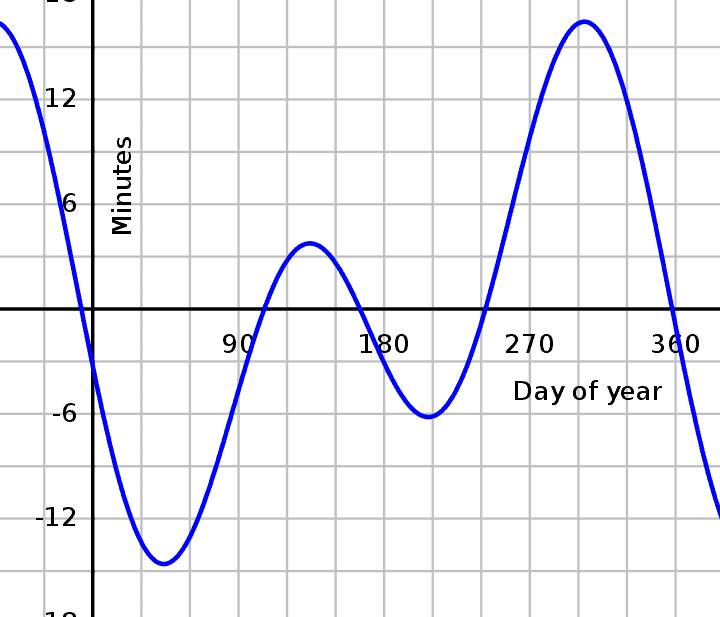This article is derived from the document titled “True Solar Time and Mean Solar Time. Local Time and World Time. Belt, Decimal Time” found in the “Astronomy” category of the archive. The archive can be accessed through the file archive and is not limited to a single section. Specifically, the document can be found in the “Essays, Papers, and Presentations” section under the “Astronomy” subject.
Online document “668” available for viewing
Text from document “668”
Report on
Understanding the difference between true solar time and mean solar time. Comparing local and universal time. Exploring belt time and decrescent time.
Conducted by
Table of contents
2. Exploring local and universal time 4
3. Understanding belt and decrescent time 4
The duration of time between two consecutive (upper or lower) culminations of the center of the solar disk is known as a true solar day. However, using this unit of time is inconvenient for two reasons. Firstly, the Sun’s visible movement does not occur along the celestial equator, but rather along the tilted ecliptic, which is tilted by [angle]. Additionally, this movement is not uniform due to the elliptical shape of Earth’s orbit, resulting in varying speeds of motion throughout the year. As a result, the duration of a true solar day slightly fluctuates from day to day.
In practical applications (such as in science, technology, and production), the average solar day is used as the standard unit of time.
Instead of using the center of the true Sun, the duration of the average solar day is determined by a point that moves uniformly along the celestial equator, completing a full revolution in one year. This imaginary point is known as the average sun. The average solar day is measured as the time between two consecutive culminations of the average sun, which always have the same length of 24 average hours, approximately 1/365.24 of a year. The Sun is an ordinary star within our galaxy, but it differs from others in its proximity to us. Due to the Earth’s motion, the Sun appears to shift against the background of other “fixed” stars, requiring the Earth to rotate for the Sun to reach the same meridian. As a result, the average solar day is 3 minutes and 56 seconds longer than the sidereal day (the time it takes for a star to return to the same meridian). Similar to sidereal days, each hour of the average solar day consists of 60 minutes, and each minute consists of 60 seconds.
Until 1956, the duration of a second was defined as being equal to 1/86,400th part of the average solar day, which was determined by the rotation of the Earth on its axis. In 1960, the XIth General Conference on Weights and Measures adopted a more precise definition of the second, based on the value recommended by the IXth Congress of the International Astronomical Union (IAU) in 1955. According to this definition, a second is equal to 1/31,556,925.9747th part of the tropical year as it was at the beginning of 1900. This more accurate second was referred to as an “ephemeral” second and is determined with a small margin of error. The starting point for measuring the average solar day is the moment of the lower culmination of the average sun. This time measurement is known as “civil time”.
In Russia, the civil time has been used in the national economy since 1919, and in astronomy since 1925. The clocks we utilize are adjusted based on mean solar time, rather than true time. This is because the average speed of the sun remains constant, but it may pass through the meridian earlier or later than the true sun, resulting in the average day occurring earlier or later than the true day.
The difference between the true solar time and the mean solar time, denoted as η, is known as the equation of time. Therefore, at any given moment, the mean solar time is equal to the true solar time plus the equation of time η, as follows:
where η has a positive value when the true Sun is ahead of the mean Sun on the ecliptic, and a negative value when the mean Sun is ahead of the true Sun. (In astronomy, a sign represents the Sun.)
Figure 1 displays a chart illustrating the fluctuation of the equation of time throughout the year, with each point representing a half-month interval. The equation of time reaches zero on approximately April 15, June 14, August 31, and December 25, aligning the true time with the mean solar time. On these dates, a clock set to the mean solar time will show 12 noon. The equation of time exhibits its most negative value (see Figure 4) of η= -16.5 minutes around November 4, and its most positive value of η= +14.3 minutes on February 12.
Based on the definition of mean solar time, it is specific to the location of observation. Consequently, each meridian on Earth has its own unique value for mean solar time, also referred to as local mean time.
Each meridian has a fixed local time at any point along it. However, as the longitude of the observation location changes, so does the local mean time. When it is noon in Moscow, it will be midnight on the opposite side of the globe, which is 180° west or east of Moscow. The celestial sphere appears to turn 1/24th of its full revolution in one hour, equivalent to 15° in angular units. Therefore, two points on Earth with a longitude difference of 15° will have a 1-hour difference in local time. If we move 30° in longitude from the original observation location, the local time will differ by 1 hour (either earlier or later, depending on the direction of movement). By comparing the readings of clocks set to local time at different points on Earth, the difference in longitudes between these points can be determined.
According to the international agreement (Rome, 1883), the initial meridian for measuring geographical longitudes on Earth is the Greenwich meridian with a longitude of , and the local time at Greenwich is used as the reference for counting. This is also known as universal or world time ( ). Thus, when it is midnight in Greenwich (near London), which is 00 h 00 min 00 s of mean local time, the local time at any other point on Earth will be equal to the longitude of that point expressed in hours. In other words, the difference in longitudes between two points is equal to the difference in local times at those points at the same moment. This forms the basis for defining longitude.
The presence of different local times in points located on different meridians has caused numerous inconveniences.
In 1878, Canadian engineer S. Fleming came up with the concept of the belt time ( ), which was officially accepted at the International Astronomical Congress in 1884. Fleming’s proposal involved dividing the entire surface of the Earth into 24 time zones, each spanning 15 degrees of longitude (equivalent to 1 hour). The time in each point within a time zone would be set according to the average meridian of that zone.
Each of the 24 time zones is assigned a unique number ranging from 0 to 23. The zero time zone is considered to be the zone with the Greenwich Mean Meridian, which serves as the reference point for numbering the zones from west to east. The mean meridian of the first zone is located 15° east of the Greenwich meridian, resulting in a time difference of 1 hour ahead. The mean meridian of the second zone is situated at an east longitude of 30°, creating a time difference of 2 hours from the universal (Greenwich) time, and so forth. Therefore, the number of each time zone indicates the number of complete hours by which the time in that zone differs from universal time (ahead of it), while the minutes and seconds remain unchanged across all zones. Consequently, the zone time shifts by 1 hour when transitioning from one zone to the adjacent one. If we denote the zone number as n, then the zone time is equivalent to the world time plus n, meaning it is equal to the world time.
The time zones have specific names for the different regions. For instance, the zero zone is referred to as Western European Time, the first zone is known as Central European Time, and the second zone is called Eastern European Time.
The concept of time zones originated in Canada and the United States in 1883, and later spread to some European countries in the early 20th century.
In our country, the time zone was initially implemented on July 1, 1919, in accordance with the Decree of the Soviet of People’s Commissars of the RSFSR on February 8, 1918. Initially, it was primarily used for navigation purposes.
Russia is divided into 11 different time zones, ranging from the 2nd to the 12th. Moscow is located in the second time zone, although only a small part of the city is actually in this zone. The majority of Moscow lies to the east of the meridian that separates the second and third time zones. As a result, the local time in Moscow is half an hour ahead of the zone time, also known as Moscow time. Generally, the boundaries of the time zones in Russia are determined by the borders of administrative units such as regions, territories, and republics.
Originally, the second time zone in Russia was only used for railroads and telegraph communication. However, with the Decree of the USSR Council of People’s Commissars on January 17, 1924, the time zone system was implemented throughout the entire USSR.
With the aim of maximizing the use of natural daylight, such as by aligning the working day symmetrically with noon, and for various economic considerations, many countries around the world adjust their clocks forward by one or more hours during the summer months, creating what is commonly known as daylight saving time. daylight saving time.
For instance, France implemented this practice in April 1916, which was subsequently adopted by several other nations.
In our country, the concept of summer time has been implemented on multiple occasions. The most recent instance occurred on June 16, 1930, when, in accordance with a decree by the USSR SNK, the clocks in all regions of the country were adjusted forward by one hour from the standard zone time. However, the clocks were not reset back to their original position afterwards, resulting in the establishment of a new time known as “decree time,” which differed from the zone time by one hour. This decree time remained in effect throughout the year until April 1, 1981. However, certain regions of the USSR, as determined by the State Commission for Uniform Time and Reference Frequencies, did not adopt decree time and instead maintained the same time as Moscow. Consequently, various autonomous republics, oblasts (including Voronezh oblast), and autonomous okrugs continued to operate on the decree time of the second zone (commonly referred to as Moscow time) throughout the year, even though, for instance, the Komi ASSR was situated in the 4th time zone and thus was two hours behind its local time.
As a result of all of this, the power grid of the country now incorporates multiple significant industrial zones, leading to a massive surge in demand on the power system at peak times.
Significant changes have occurred in the economies of the Northern regions, Far East, Siberia, and Kazakhstan in recent years. These areas have experienced noticeable population growth and the emergence of new cities and powerful territorial-production complexes, leading to the creation of large industrial centers. In the past, the division of time zones, particularly the border between the sixth and seventh time zones in Eastern Siberia, caused inconvenience as it split the Evenki Autonomous Okrug into two parts along the meridian line. To address this issue, new time zone boundaries were established on the map of the USSR starting from October 1, 1981 (Fig. 5; different lines indicate: 1 – time zone boundaries introduced in 1981, 2 – boundaries that existed before 01.10.81, 3 – meridians). Consequently, on April 1, 1981, after the Kremlin chimes rang 12 times, the radio announced that it was one o’clock in the morning in Moscow, the capital of our Motherland. Following this announcement, all clocks in the country were set one hour ahead, marking the transition to daylight saving time. However, on October 1, 1981, the clocks were not set back everywhere, ensuring a more regularized time calculation within all time zones and the restoration of belt time across the entire territory of the USSR.
Every year in Russia, the clock is adjusted on the last Sunday of March by moving the hands one hour forward. Similarly, on the last Sunday of October, the clock is adjusted by moving the hands one hour backward. This transition from daylight saving time (winter time) to summer time and vice versa is regularly conducted.
The purpose of implementing summer time is to create an additional hour during daylight saving time, allowing for a more efficient use of morning light. Based on expert calculations, this “summer” hour in our vast country, with its robust industry, saves over two billion kilowatt-hours annually. This amount of electricity would be sufficient to power several million apartments. Overall, daylight saving and summer time combined save approximately 7 billion kilowatt-hours per year.
Based on a specially conducted research, doctors have concluded that moving the clock forward does not have an impact on people’s well-being. In fact, it has been found that having an “extra hour” of daylight helps reduce the phenomenon known as “light starvation” and alleviates stress on vision. Transitioning from summer time to winter time also does not pose any inconvenience to daily life. Moreover, when it comes to railroad transportation, long-distance travel, and telegraphic communications, they all operate according to Moscow time across Russia.
This professional calculator is designed to calculate solar time and variable (or “rubber”) time. It is widely used by practitioners of batsu, feng shui, and qi lesser dun jia to determine auspicious dates for important events, activations, and birth chart analysis.
Why should you make use of this calculator?
Time holds significant importance in various systems of Chinese metaphysics, with measurements that differ from our familiar European time. In ancient China, the measurement of time relied on the sun’s shadow and a device known as a “gnomon”. These measurements accurately reflected the solar time within the region.
The day was divided into 12 equal parts, with each part equivalent to two European clocks. This gave rise to the concept of the Chinese two-hour clock.
For instance, the “hour of the tiger” spanned from 3 to 5 o’clock, while the “hour of the horse” encompassed the period from 11 to 13 o’clock, and so on.
Chinese metaphysics knowledge is now being utilized globally, not just in China. However, it is necessary to reevaluate the duration of the Chinese two-hour clock for each specific location due to the existence of time zones, which are determined by geopolitical factors rather than actual geography. For instance, neighboring cities separated by administrative boundaries can have a time difference of up to 2 hours, even though they should theoretically have the same time based on their geographical proximity. This is because true solar time is not influenced by administrative territories and is instead calculated based on the sun’s movement in the sky.
Consequently, there is a discrepancy between the time displayed on clocks and true solar time.
This discrepancy is known as “solar time correction.” These calculations can be quite complex and time-consuming.
Section “SOLAR TIME” Our calculator provides a quick and simple way to determine the duration of the Chinese two-hour clock for any location, without the need for complex calculations involving corrections, time zones, or the movement of the sun. For instance, in Moscow, the hour of the tiger lasts from 3:30 to 5:30, while the hour of the horse lasts from 11:30 to 13:30 (with a 30-minute correction), and so on.
In addition, the original two-hour measurement system was developed in an area where the length of the day is roughly equal to the length of the night throughout the year. All measurements were based on observations of the sun, including sun shadows, sunrise, and sunset.
In more northerly latitudes, the length of daylight and darkness varies significantly throughout the year. Building upon this understanding, our colleague Alexander Anishchenko has proposed a theory concerning the “variable divisions of time” (commonly referred to as “elastic time”).
The computation of “elastic time” aims to provide further clarity on the duration of the Chinese two-hour clock for a specific location.
The “DAY TIME” section of our calculator allows for this computation to be carried out without delving into the intricacies of studying the length of daylight in different seasons at various latitudes.
Who developed this calculator and who is its owner?
This calculator is the creation of Sakhranova Oksana, a seasoned consultant and instructor specializing in Feng Shui and Batsu. With over 20 years of experience, Sakhranova Oksana has utilized her extensive knowledge of Chinese metaphysics to develop this calculator specifically tailored for the European region. To delve further into Sakhranova Oksana’s expertise and her school, please visit here>>



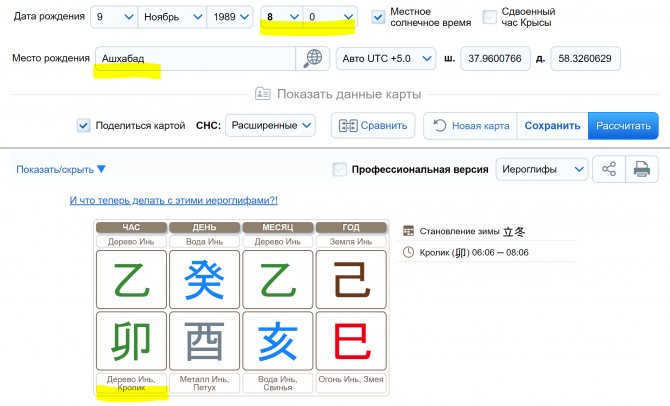

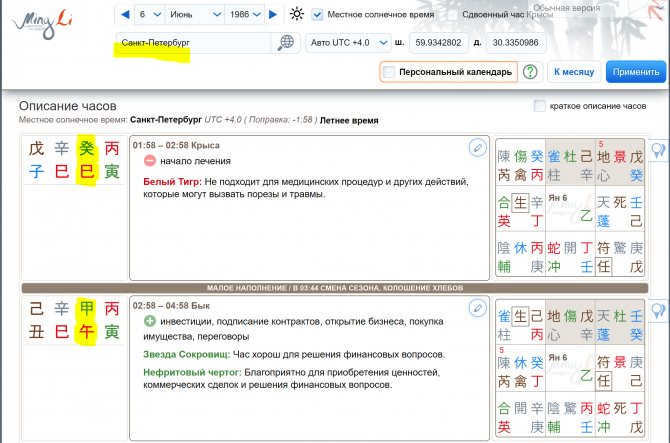
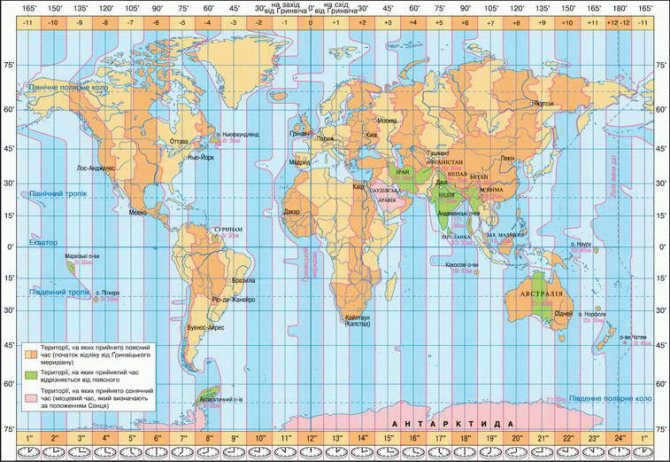
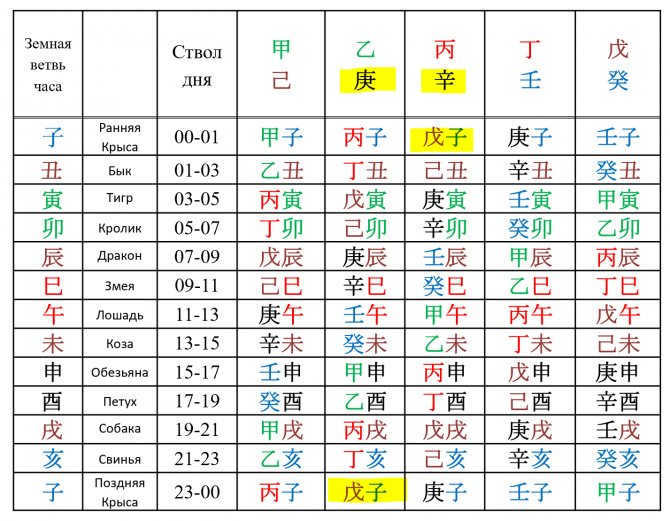
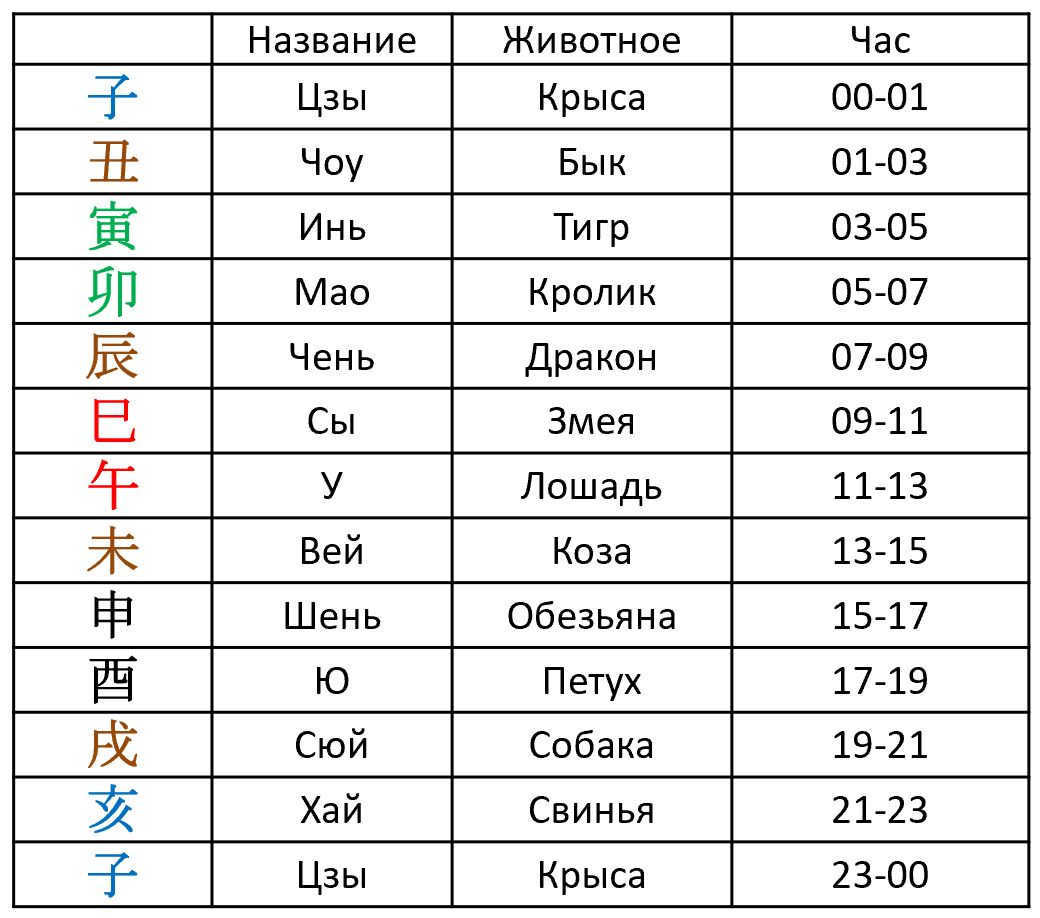
On the vast expanse of the Internet, you can come across both paid and free calculators. However, it’s worth noting that not all calculators found online display accurate results. That’s why I highly recommend using a reliable calculator that we have been using for over 6 years. While this calculator is not available for free, if you require a calculation for your specific city, please leave a comment below this article stating the month for which you need the calculation and the name of your city. For instance, you can write “Moscow city, from 21.05-21.06”.
Additionally, there is a concept known as Combined Time – which refers to the period when both solar time and standard time align. This can be useful for individuals who are unsure about which time to follow. You may consider using Combined Time for significant occasions such as moving, launching a website, or conducting business activities.
P.S. This article is written based on the experiences and practices of the creators and users of our website. If the calculations and analyses done using Solar Time have been consistently effective for years, we have no intention of persuading you otherwise
Give it a try, observe the results, and feel free to share your observations in the comments section. It can be helpful for everyone.
Overall forecast
A solar eclipse takes place when the Moon moves between the Sun and the Earth, resulting in the partial coverage of the solar disk. This phenomenon occurs when a new moon, which is the alignment of the Sun and Moon, happens near one of the Lunar Nodes. If people in any location on the Earth’s surface can witness the Moon completely blocking the Sun, it is referred to as a total solar eclipse. Typically, a total solar eclipse can only be observed within narrow regions on the Earth’s surface, usually a strip that is up to 270 km wide. This strip is determined by the shadow cast by the Moon, while individuals in nearby shaded areas can only experience a partial solar eclipse.
The impact of a Solar Eclipse is in effect for two weeks prior to the eclipse and two weeks after. The eclipse creates a dangerous pathway for the next 18.5 years, so it is crucial to have positive thoughts. However, it is important for your desires to be passionate and intense. By harnessing your personal energy, known as Shakti, you can create a strong positive direction for the next 18 years.
It is crucial to approach the Solar Eclipse in a calm, joyful, and spiritual state. During the eclipse, portals connected to Lucifer’s energies are opened, which activates “dark forces.” As a result, conflicts, arguments, increased mortality rates, higher crime rates, and various disasters such as natural catastrophes, automobile accidents, and aviation incidents are possible during Solar eclipses (two weeks before and two weeks after).
During the occurrence of a Solar Eclipse, there is a possibility of experiencing headaches, surges in pressure, heartaches, and worsening of chronic illnesses. This period is characterized by provocations, illusions, and delusions. However, if you approach the eclipse with a positive mindset and fully prepared, you have the ability to significantly influence the next 18.5 years.
During Solar eclipses, you have the opportunity to create thought forms that are related to programming your future. It is advisable to focus on thought forms that are oriented towards social and material aspects. For instance, if you desire new friendships, a change in your career, or the realization of important and interesting projects, it is best to concentrate on these desires in the social realm. Additionally, it is beneficial to wish happiness and well-being for your friends, children, and relatives. Lastly, reciting suitable mantras or prayers during an eclipse, even if done mentally, is considered to be the most effective practice.
Here are some practical tips for enhancing your life during a solar eclipse:
- Before the eclipse begins, find a comfortable spot and lay down with your head facing East. Prior to this, set up candles on either side of the world using a compass for guidance. You can also light incense to create a serene atmosphere.
- Take this time to project your positive thoughts and desires into the future. Visualize yourself achieving success in various aspects of your life such as society, work, profession, creativity, destiny, and relationships. Speak these thoughts aloud and focus on them passionately.
- Conclude your eclipse ritual with a prayer or mantra-meditation. One of the most powerful ways to connect with the divine is by chanting the Names of God. This practice is recognized and revered by all religions. By repeating these holy Names, whether aloud or silently, you not only protect yourself from negative energies associated with the eclipse, but also cleanse yourself of accumulated sins and various forms of negativity. Choose mantras or prayers that resonate with you and contain the Names of God, as the divine Name is a potent purifying agent.
Guidelines for behavior during a solar eclipse: 1. It is crucial to minimize exposure to the sun’s rays during the eclipse. Avoid looking directly at the sun for several days before and after the eclipse. If possible, it is best to stay indoors. 2. Refrain from making important decisions in any aspect of life, especially if unsure of their correctness. 3. Limit food consumption on the day of the eclipse and consider fasting for the day. It is advisable to avoid consuming animal products, alcohol, cigarettes, etc. 4. Avoid crowded places and postpone any auto/air travel plans. 5. It is not recommended to wash or hang laundry outside in the sun. 6. Avoid watching TV, listening to the radio, engaging in gossip, or passing judgment on others. 7. Doctors, astrologers, psychologists, etc., should postpone consultations and patient appointments. 8. Spending the day in peace, prayer, and performing rituals can be beneficial. Lighting candles, burning incense, visiting temples, and engaging in spiritual activities are encouraged. Reading spiritual literature is also favorable. 9. Half an hour before the eclipse, perform ablution (a contrast shower with 3-5 temperature changes) and wear clean clothes. Repeat the ablution one hour after the eclipse.
Magic
Solar eclipses are extraordinary days with a unique psychological, energetic, and enchanting atmosphere. The day of a solar eclipse possesses a true sense of mysticism: dark sorcerers and magicians cast spells that are nearly impossible to remove, perform rituals that alter the destiny of entire states and regions. The magic invoked during a solar eclipse profoundly affects a person’s psyche, making it difficult to recover from such a supernatural blow. The consequences of this magical intervention are severe. The solar eclipse phenomenon is utilized to influence a person’s physical well-being. If you are a novice and unsure of how to control this power, it is advisable to refrain from engaging in strong, serious rituals, as the force can turn against you with great intensity.
List of eclipses solar eclipses lunar eclipses SharePopular lunar calendars
Phases of the Moon
Lunar eclipses occur when the Moon, Earth’s natural satellite, falls into the shadow of our planet.
2021 Equinox and Solstice Dates
The astronomical seasons do not align with the calendar year and transition during the solstice and equinox days.
Today’s Sunrise and Sunset
Choose a date on the calendar to discover details about the Sun and other planets’ rising and setting times.
Planets nearing and receding from Earth
Computed information regarding the closest and farthest distances of all planets to the orbit of Earth. Leap
calculations 20 → horoscopes 16 all lunar calendars 42
Feedback (5):
Add comments Irina Hi, can you please explain what happens to a person born during an eclipse? And what if they are also born on Friday the 13th, on the 29th day of the Moon? 31.05.2020 at 04:30 am Reply Louise I’m curious, why is it believed that it’s not good to sleep during an eclipse? 14.08.2018 at 17:48 Alexei Hi, Louise! This is an ancient belief and it’s hard to say for sure, but during an eclipse, the influence of dark spirits and demonic beings on Earth is said to increase. The movement of vital energy in all living beings slows down, cells become stressed, mental efficiency decreases, and diseases may worsen. Immunity is also at its lowest. Eclipses create a channel of communication between the spiritual world and our physical world, making our thoughts more influential. If you sleep during an eclipse, you are more susceptible to negative influences. 19.08.2018 at 14:06 Natalie What is the fate of a child born during a solar eclipse? 20.08.2018 at 21:56 Alexei Hi, Natalie! The fate and life circumstances of people born during a solar eclipse can be quite complicated. However, it’s important to note that the individual horoscope and personal behavior during eclipses also play a significant role in determining one’s destiny. 21.08.2018 at 17:18 comment
| The position of the moon and stars has a significant impact on one’s character and life, and can even determine their fate and influence their decisions. Depending on the moon’s location in a particular zodiac sign, it can bring both good luck and happiness, or misfortune and bitterness. To protect yourself and your loved ones, and to avoid conflicts in both work and personal life, it’s important to pay attention to the stars and take control of your own destiny! go → | A lunar month typically lasts for 29 or 30 lunar days. Throughout the month, the moon goes through four phases: new moon, first quarter, full moon, and last quarter. These phases change based on the positions of the Sun, Earth, and Moon, which affects the amount of the Moon’s surface that is illuminated by the Sun. go → | A personal horoscope is created based on a person’s time and place of birth. It provides insights into one’s karma, abilities, and potential circumstances that may impact their life path. By creating a birth chart, you can determine the cosmogram, which shows the arrangement of planets in the zodiac and houses. go → |
- Haircuts
- Coloring
- Health
- Weight Loss
- Beauty
- Gardening
- Sowing
- Fishing
- Dreams
- Gender of a child
- Conceiving a child
- Relocating to a house
- Aromatherapy
- Shopping
- Wedding
- Travel
- Natal chart
- Transits
- Lilith Calculation
- Selenium Calculation
- Solar and lunar
- Progressions
- Directions
- Synastry
- For January
- February
- March
- April
- May
- June
- For 2021
- For this year
- For today
- January
- Eclipses
- Moon off track
- Moon Aspects
- Morning
- Lunar Eclipse
- Spring Equinox
- About Us
- Compose a Letter
- Frequently Asked Questions
- Membership
- Glossary
- Online Consultation
- Project Assistance
© 2021 – 2021 Lunnik.rf – lunar calendar for each day, Moscow.
On a planet with an irregular orbit like Earth, the length of a sidereal day is shorter than that of a solar day. At time 1, the Sun and a distant star are directly overhead. At time 2, the planet has completed a full rotation of 360 degrees and the distant star is again directly overhead (1 → 2 = one sidereal day). However, shortly after, at time 3, the Sun is once again directly overhead (1 → 3 = one solar day). In simple terms, the time span between 1 and 2 represents the Earth’s complete rotation, but due to the Earth’s orbit around the Sun, which affects the angle at which the Sun is visible from Earth, the time span between 1 and 3 represents the duration it takes for half a day to elapse.
Solar time refers to the measurement of time based on the position of the Sun in the sky. The day serves as the fundamental unit for solar time. There are two distinct types of solar time, namely apparent solar time (also known as sundial time) and mean solar time (also known as clock time).
- 1 Introduction
- 2 Apparent solar time
- 3 Mean solar time
- 4 History
- 5 See Also
- 6 References
- 7 External links
Overview
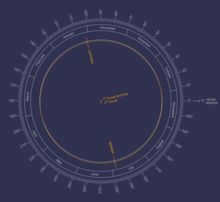
The Earth’s path around the Sun can be seen in the image above, which illustrates its eccentricity.
On a sunny day, a tall pole that is fixed vertically in the ground will create a shadow. At a certain point during the day, this shadow will align precisely with either the north or south direction. Alternatively, the shadow will disappear if the Sun is directly overhead. This specific moment is known as apparent local noon or 12:00 local apparent time. Approximately 24 hours later, the shadow will once again align from north to south, indicating that the Sun has completed a full 360-degree rotation around the Earth’s axis. When the Sun has moved precisely 15 degrees (which is equivalent to 1/24th of a circle, with both angles measured in a plane perpendicular to the Earth’s axis), the local apparent time will be exactly 13:00. Another 15 degrees of rotation will bring the time to exactly 14:00.
The issue lies in the fact that the Sun takes a different amount of time to complete one apparent revolution in September compared to December, according to a precise clock. In solar time, 24 “hours” can be either 21 seconds shorter or 29 seconds longer than 24 hours of conventional clock time. This variation is known as the equation of time and is influenced by the Earth’s orbit eccentricity (i.e. the Earth’s orbit is not a perfect circle, causing the Earth-Sun distance to vary throughout the year) and the tilt of the Earth’s axis in relation to the plane of its orbit (referred to as the ecliptic tilt).
In consequence, a clock that maintains a consistent rate – for instance, executing the identical amount of oscillations of the pendulum for each hour – cannot synchronize with the authentic Sun; instead, it aligns itself with an imaginary “average Sun” that progresses along the celestial equator at an unchanging velocity equal to the mean speed of the actual Sun throughout a year. This is referred to as “mean solar time,” which, although not precisely uniform from one century to another, is nearly accurate for most intents and purposes. At present, the average duration of a solar day is approximately 86,400,002 SI seconds.
The three types of timekeeping traditionally used by astronomers until the 1950s include apparent solar time, mean solar time, and sidereal time. Apparent solar time and mean solar time are based on the Sun’s apparent motion, while sidereal time is based on the motion of other stars. However, it was discovered by the 1950s that the Earth’s rotation rate was not constant. As a result, astronomers introduced ephemeris time, a time scale that takes into account the positions of celestial bodies in their orbits.
Perceptible solar time
Perceptible solar time or accurate solar time is derived from the observable Sun as observed by an individual on the surface of the Earth. Perceptible solar time is determined by the apparent movement of the actual Sun. It is determined by observable solar days, the duration between two successive appearances of the Sun at the particular meridian. Solar time can be approximately calculated using a sundial. The corresponding concept on different celestial bodies is referred to as local accurate solar time (LAST).
The duration of the solar day changes throughout the calendar year, resulting in seasonal variations of up to 16 minutes from the average. This phenomenon is primarily caused by two factors. Firstly, due to the elliptical shape of the Earth’s orbit, the Earth moves faster when it is closest to the Sun (known as perihelion) and slower when it is farthest from the Sun (known as aphelion) (as explained by Kepler’s laws of planetary motion). Secondly, the tilt of the Earth’s axis (referred to as ecliptic tilt) causes the Sun’s annual movement to occur along a tilted great circle (known as the ecliptic) that is inclined towards the Earth’s celestial equator. During the equinoxes, when the Sun crosses the equator, its daily displacement (relative to the background stars) is at an angle to the equator, resulting in a smaller projection of this displacement on the equator compared to the annual average. Conversely, during the solstices, when the Sun is farthest from the equator, the Sun’s position displaces parallel to the equator, leading to a larger projection of this displacement on the equator compared to the annual average (as explained by the tropical year). In June and December, when the Sun is furthest from the celestial equator, this displacement of the ecliptic corresponds to a significant displacement at the equator. Consequently, the visible solar days in March and September are shorter than those in June or December.
| February 11 | 24 hours |
| March 26 | 24 hours – 18.1 seconds |
| May 14 | 24 hours |
| June 19 | 24 hours + 13.1 seconds |
| July 25/26 | 24 hours |
| September 16 | 24 hours – 21.3 seconds |
| November 2/3 | 24 hours |
| December 22 | 24 hours + 29.9 seconds |
These durations will experience slight changes in a few years and significant changes in thousands of years.
Average solar time
The sundial will appear to be running faster than a clock showing the average local time when it is above the axis, and slower when it is below the axis.
The hour angle of the mean sun plus 12 hours represents the mean solar time. This offset of 12 hours is due to the decision to start each day at midnight for civic purposes, while the hour angle or mean sun is calculated from the local meridian. Currently (2009), the UT1 time scale is used for this calculation, which is derived from interferometry with a vast database of observations of diurnal motions of radio sources in other galaxies and other observations. While the length of the daylight hours varies throughout the year, the length of an average solar day remains relatively constant, unlike an apparent solar day. An apparent solar day can be either 20 seconds shorter or 30 seconds longer than an average solar day. These longer or shorter days occur consecutively, causing the difference between average time and apparent time to increase. By around February 6, the average time is ahead of the apparent time by about 14 minutes, while around November 3, the average time is behind the apparent time by about 16 minutes. The equation of time represents a cyclical difference that does not accumulate from year to year.
The average time is determined by the average sun. According to Jean Mius, the average Sun can be described as follows:
Imagine a hypothetical Sun that moves along the ecliptic at a constant speed and aligns with the actual Sun at perigee and apogee (when the Earth is closest and farthest from the Sun, respectively). Now, picture a second hypothetical Sun moving along the celestial equator at a constant velocity and coinciding with the first hypothetical Sun at the equinoxes. This second hypothetical Sun is known as the mean Sun. "
Due to the tidal acceleration of the Moon by the Earth and the resulting slowing down of the Earth’s rotation caused by the Moon, the length of an average solar day gradually increases.
Historical Background
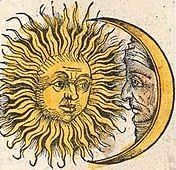
The depiction of the Sun and Moon in the Nuremberg Chronicles of 1493 showcases ancient methods used to determine mean solar time. Over the course of history, various techniques have been employed for this purpose. One such method was the use of klepsydras, also known as water clocks, which were utilized for almost four thousand years starting from the mid-2nd millennium BC until the early 2nd millennium. During the initial stages, these water clocks were calibrated to align with the apparent solar day, making them no more accurate than the shadow cast by a gnomon (a vertical pole). However, their advantage was that they could also be utilized during nighttime.
However, it has been common knowledge for quite some time that the Sun moves in an eastward direction in relation to the fixed stars along the ecliptic. For centuries, astronomers have been using the daily rotation of the fixed stars to calculate values in solar time, which was then used to compare and determine the accuracy of clocks. The Babylonian astronomers were aware of the equation of time and made corrections for it, as well as accounting for the varying rotation rates of the stars (stellar time) in order to obtain a more precise average solar time compared to their water clocks. This highly accurate mean solar time has been utilized ever since to describe the movement of the planets, moon, and sun.
The accuracy of mechanical clocks did not match that of Earth’s “star clocks” until the early 20th century. Nowadays, atomic clocks are much more precise than Earth’s clocks, but the star clocks are still utilized to determine average solar time. In the late 20th century, scientists determined the Earth’s rotation relative to a collection of extragalactic radio sources and then converted it to mean solar time according to an accepted ratio. The difference between this calculated mean solar time and Coordinated Universal Time (UTC) determines whether a leap second is necessary. (The UTC time scale now operates on SI seconds, and the SI second, when established, was already slightly shorter than the current value of a mean solar second.)
Check out these related articles:
Additional background information:
External resources:
On a dynamic planet like Earth, the length of a sideric day is shorter than that of a solar day. Solar. At time 1, both the Sun and a distant star align directly overhead. By the time 2 rolls around, the planet has completed a full 360° rotation, and the distant star once again takes its place overhead (1→2 equals one sidereal day). However, shortly after, at time 3, the Sun returns to its overhead position (1→3 equals one solar day). In simple terms, 1-2 represents a complete revolution of the Earth, while 1-3 takes into account the Earth’s orbital motion around the Sun, which affects the angle at which the Sun is observed from the Earth, determining when noon occurs.
Solar time is a way to measure the progression of time by considering the position of the Sun in the sky. The main unit of solar time is the day, which is determined by the synodic rotation period. There are two types of solar time: apparent solar time, also known as sundial time, and mean solar time, which is the time displayed on clocks.
Overview
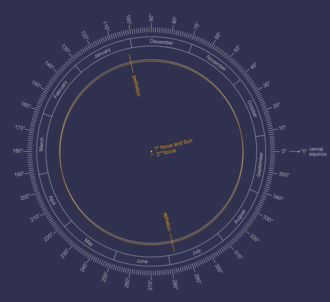
On any given sunny day, a tall pole that is fixed vertically in the ground will create a shadow. There comes a point during the day when the shadow will be pointing directly north or south, or it may disappear altogether if the Sun is directly overhead. This specific point in time corresponds to noon local time or 12:00 pm. In approximately 24 hours, the shadow will once again be directed north-south, indicating that the Sun has completed a full 360-degree arc around the Earth’s axis. When the Sun has moved exactly 15 degrees (which is equivalent to 1/24th of a circle) in a plane that is perpendicular to the Earth’s axis, the local apparent time will be exactly 13:00. After another 15 degrees of movement, the local apparent time will be exactly 14:00.
The issue lies in the fact that the Sun takes a shorter amount of time (as measured by a precise clock) to complete a visible orbit in September compared to December; a solar day can be either 21 seconds shorter or 29 seconds longer than a clock day. This fluctuation is known as the equation of time and is influenced by the elliptical shape of the Earth’s orbit (meaning that the distance between the Earth and the Sun changes throughout the year) and the tilt of the Earth’s axis in relation to its orbit (referred to as the ecliptic tilt).
The outcome of this is that a clock that runs at a consistent pace – for instance, completing the same number of pendulum swings in each hour – is unable to synchronize with the actual Sun; instead, it tracks an imaginary “mean Sun” that moves along the celestial equator at a steady velocity equivalent to the average velocity of the real Sun throughout a year. This is a “mean solar time” that is still not completely consistent from one century to another, but is sufficiently close for most intents and purposes. Presently, the average solar day is approximately 86,400,002 SI seconds.
The three types of time calculations used by astronomers until the 1950s are apparent solar time, mean solar time, and sidereal time, which is based on the apparent motion of stars other than the Sun. However, it was discovered in the 1950s that the Earth’s rotational speed was not constant. As a result, astronomers developed ephemeris time, a time scale that is based on the position of solar system bodies in their orbits.
Perceptible solar time
The perceptible sun is the authentic sun as observed by an individual on Earth. Perceptible solar time or true solar time is determined by the visible movement of the physical sun. It is determined by the visible solar day. the duration between two consecutive appearances of the Sun at the local meridian. The visible solar time can be approximately gauged with a sundial. The equivalent on Mars is referred to as Martian true solar time. (LTST).
The length of the solar day changes throughout the year, resulting in seasonal variations of up to 16 minutes from the average duration. These variations are caused by two main factors. Firstly, due to the elliptical shape of Earth’s orbit, the planet moves faster when it is closest to the Sun (perihelion) and slower when it is farthest from the Sun (aphelion), in accordance with Kepler’s laws of planetary motion. Secondly, the tilt of Earth’s axis, known as the ecliptic tilt, plays a role. The Sun’s annual movement occurs along the ecliptic, a great circle inclined to Earth’s celestial equator. During the equinoxes, when the Sun crosses the equator, its daily displacement (relative to the background stars) is at an angle to the equator. As a result, the projection of this displacement on the equator is less than the yearly average. Conversely, during the solstices, when the Sun is farthest from the equator, its position shifts parallel to the equator, causing the projection on the equator to be greater than the average. This is known as the tropical year. In June and December, when the Sun is farthest from the celestial equator, this shift along the ecliptic corresponds to a significant shift at the equator. Consequently, the visible solar days in March and September are shorter compared to June or December.
| February 11 | 24 hours |
| March 26 | 24 hours – 18.1 seconds |
| May 14 | 24 hours |
| June 19 | 24 hours + 13.1 seconds |
| July 25/26 | 24 hours |
| September 16 | 24 hours – 21.3 seconds |
| November 2/3 | 24 hours |
| December 22 | 24 hours + 29.9 seconds |
These durations will experience slight changes in a few years and significant changes in thousands of years.
Mean solar time
The equation of time causes the sundial to appear fast or slow compared to a clock showing the average local time, depending on whether it is above or below the axis.
Mean solar time is equal to the hour angle of the mean sun plus 12 hours. This 12-hour offset arises from the decision to commence each day at midnight for civilian purposes, while the hour angle or mean sun is gauged from the local meridian. As of 2009, this is achieved using the UT timescale1, which is constructed mathematically from interferometric observations with an extremely long base of diurnal motion of radio sources situated in other galaxies and other observations. The duration of the daylight hours fluctuates throughout the year, but the duration of an average solar day remains relatively constant, unlike the apparent solar day. An apparent solar day can be 20 seconds shorter or 30 seconds longer than an average solar day. The longer or shorter days occur consistently, thus the discrepancy increases until the mean time is ahead of apparent time by approximately 14 minutes around February 6 and behind apparent time by roughly 16 minutes around November 3. The equation of time represents this variation, which is cyclical and does not accumulate from year to year.
The mean sun is defined by Jean Meus as the sun that follows the average path along the ecliptic, coinciding with the true sun at perigee and apogee. Another fictitious sun, known as the average sun, moves along the celestial equator at a constant velocity and aligns with the first fictitious sun at the equinoxes.
The average sun is the result of these two fictitious suns, representing the average position of the sun throughout the year.
Over time, the length of a solar day gradually increases due to the tidal acceleration of the Moon by the Earth and the resulting slowing down of the Earth’s rotation.
Background

Throughout history, the Sun has been a constant presence in the sky, serving as the foundation for apparent solar time, an ancient method of time measurement. The early civilizations of Egypt and China developed various tools to determine the sun’s position, such as an Egyptian obelisk constructed around 3500 BC, a Chinese gnomon dating back to 2300 BC, and an Egyptian sundial from 1500 BC.
Babylonian astronomers were aware of the fact that the length of daylight hours changed throughout the year. In a tablet dating back to 649 BC, it can be seen that they used a 2:1 ratio to determine the longest and shortest days, and they estimated the variation using a linear zigzag function. It is not clear whether they were aware of the difference in the length of the solar day and the corresponding equation of time. In his book Almagest (2nd century), Ptolemy clearly distinguished between an average solar day and an apparent solar day, and he provided a table with the equation of time in his work Convenient Tables.
As trade expanded and mechanical clocks advanced, apparent solar time lost its usefulness. In 1834, mean solar time was incorporated into almanacs in England, and in 1835, it was introduced in France. Since the sun’s direct observation was challenging due to its significant size in the sky, mean solar time was calculated based on a fixed ratio of the time observed from the stars. The average solar time, which relied on point observations, was determined as a fixed ratio of the time observed from the stars. This specific standard for measuring “mean solar time” from midnight eventually became known as Universal Time.
From a conceptual standpoint, Universal Time is the measurement of the Earth’s rotation in relation to the Sun, which in turn determines mean solar time. However, since 1955, UT1, the widely utilized version, has employed a slightly different definition of rotation that compensates for the Earth’s pole movement during rotation. The variance between this adjusted mean solar time and Coordinated Universal Time (UTC) determines whether an additional second is necessary. (Since 1972, the UTC time scale has operated on SI seconds, and the SI second, when it was initially adopted, was already marginally shorter than the current value of a second of mean solar time.)

